Looking after a bonsai is not as simple as it first appears, writes Jonathon Walsh.
If you think bonsai is nothing more than a baby tree parked in a pot, think again. In fact, dig a little deeper into this ancient Japanese hobby and you will see that there is much more to bonsai than at first meets the eye. Bonsai, which translates literally into “tray growing” or “tray planting,” is enjoying something of a worldwide renaissance at present, with more and more people discovering the benefits of living with small trees.
 Fifty-two-year-old Yoshi Nakamizu is a case in point. In June 2000, this self-confessed bonsai enthusiast abandoned his salaryman lifestyle after 24 years and set up his own company, Bonsai Network Japan. “I started learning about bonsai because of my strong interest in cross-cultural communication,” Nakamizu said in fluent English. “Of all traditional Japanese arts, bonsai is less well known. And yet, it is gaining in popularity everywhere.”Nakamizu is heavily involved in myriad aspects of bonsai culture. When not busy exporting bonsai and associated paraphernalia, he organizes workshops for foreign visitors and coordinates bonsai-related tours and nursery inspections. Since launching his business four years ago, he hasn’t looked back. “[My work] is very interesting,” he said. “I love what I am doing. This is what I have been dreaming of. It is the happiest time of my life.”Nakazimu said around six million people worldwide were involved in bonsai cultivation, with roughly three million of these living in China and the remainder scattered throughout the rest of the globe. Interestingly, he added, only 300,000 or so bonsai lovers resided in Japan. “In no time there will be 10 million worldwide,” he predicted.
Fifty-two-year-old Yoshi Nakamizu is a case in point. In June 2000, this self-confessed bonsai enthusiast abandoned his salaryman lifestyle after 24 years and set up his own company, Bonsai Network Japan. “I started learning about bonsai because of my strong interest in cross-cultural communication,” Nakamizu said in fluent English. “Of all traditional Japanese arts, bonsai is less well known. And yet, it is gaining in popularity everywhere.”Nakamizu is heavily involved in myriad aspects of bonsai culture. When not busy exporting bonsai and associated paraphernalia, he organizes workshops for foreign visitors and coordinates bonsai-related tours and nursery inspections. Since launching his business four years ago, he hasn’t looked back. “[My work] is very interesting,” he said. “I love what I am doing. This is what I have been dreaming of. It is the happiest time of my life.”Nakazimu said around six million people worldwide were involved in bonsai cultivation, with roughly three million of these living in China and the remainder scattered throughout the rest of the globe. Interestingly, he added, only 300,000 or so bonsai lovers resided in Japan. “In no time there will be 10 million worldwide,” he predicted.
To the Japanese, bonsai is linked to many of the ideals that their society is based on. With roots that can be traced back to Zen Buddhism, bonsai involves the manipulation of nature, time and change into a unique form of meditation and expression. In modern times, bonsai is viewed as more of a hobby that offers a greater understanding and closeness with nature, as well as a way to enhance one’s garden. “There are two big myths about bonsai,” Nakazimu said. “First, that practicing this art is expensive and, secondly, that it is enjoyed mainly by the elderly.”
Although most people believe bonsai – along with sushi and ikebana – originated in Japan, they all actually came from elsewhere. While the first reference to what is now known as bonsai was recorded in China during the Tang Dynasty (618-907), the art of tending miniature trees began in Japan during the Heian period (794-1192). During this time, Japan sent envoys to China and imported its culture and arts on a large scale – including bonsai. During the Edo era (1603-1868), the art of bonsai flourished to such a degree that it appeared on many prints and illustrations made during this period. At the end of the second world war, the tiny trees became more popular in the west after soldiers returned from Japan with bonsai in tow.
Bonsai Basics
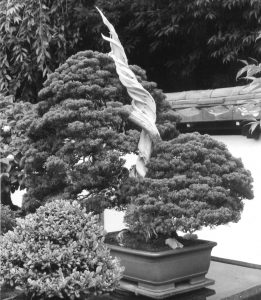 Bonsai can be grown from seeds or cuttings, from young trees or from naturally occurring stunted trees transplanted into containers. Most bonsai range in height from five centimeters to one meter. Bonsai are kept small and trained by pruning branches and roots, by periodic repotting, by pinching off new growth and by wiring the branches and trunk so that they grow into a particular shape. The artist never simply duplicates nature but rather expresses a personal aesthetic philosophy through manipulation. A bonsai may suggest many things, but in all cases must look natural and never reveal the intervention of human hands. With proper care, bonsai can live for hundreds of years, with prized specimens being passed from generation to generation, admired for their age and revered as a reminder of those who have cared for them over the centuries. These bonsai are typically renowned for their beauty, but age is usually not the most significant factor behind their charm. It is more important that the tree produces the artistic effect desired, that it be in proper proportion to the appropriate container and that it be in good health. Enthusiasts with a lot of time on their hands may prefer to break into bonsai by buying cuttings or seedlings from their local nursery and replanting them into pots. A somewhat quicker option is to buy a young bonsai and start from there. Alternatively, there is no shortage of opportunities to buy your plants, seeds, tools and supplies through magazines and online. The best soil in Japan is akadama, a traditional Japanese bonsai medium made out of granular volcanic material.
Bonsai can be grown from seeds or cuttings, from young trees or from naturally occurring stunted trees transplanted into containers. Most bonsai range in height from five centimeters to one meter. Bonsai are kept small and trained by pruning branches and roots, by periodic repotting, by pinching off new growth and by wiring the branches and trunk so that they grow into a particular shape. The artist never simply duplicates nature but rather expresses a personal aesthetic philosophy through manipulation. A bonsai may suggest many things, but in all cases must look natural and never reveal the intervention of human hands. With proper care, bonsai can live for hundreds of years, with prized specimens being passed from generation to generation, admired for their age and revered as a reminder of those who have cared for them over the centuries. These bonsai are typically renowned for their beauty, but age is usually not the most significant factor behind their charm. It is more important that the tree produces the artistic effect desired, that it be in proper proportion to the appropriate container and that it be in good health. Enthusiasts with a lot of time on their hands may prefer to break into bonsai by buying cuttings or seedlings from their local nursery and replanting them into pots. A somewhat quicker option is to buy a young bonsai and start from there. Alternatively, there is no shortage of opportunities to buy your plants, seeds, tools and supplies through magazines and online. The best soil in Japan is akadama, a traditional Japanese bonsai medium made out of granular volcanic material.
Care & Maintenance
Positioning – A bonsai tree should always be positioned off-center in its container, for not only is asymmetry vital to the visual effect, but the center point is symbolically where heaven and earth meet – and nothing should occupy this place. Another aesthetic principle is the triangular pattern necessary to achieve visual balance and reflect the relationship shared by the universal lifeforce sometimes called Qi, the artist and the tree itself. According to tradition, these three basic virtues – shin, zen and bi (truth, goodness and beauty) – are required in any bonsai.
Style – Once you have purchased and potted the new addition to your family, it’s time to give it a drink. Bonsai should generally be watered a few times a week, more often when it is warmer. Aim to keep the soil slightly damp, but not too wet. The ideal time to water bonsai is in the evening, so the tree has the whole night to absorb the liquid.
Watering & Drainage – Be sure that the pot has drainage holes at the bottom, to allow excess water to run through the soil and out the bottom of the pot. Generally speaking, water outdoor bonsai when the top of the soil is dry to the touch. For indoor plants, you should poke a finger or chopstick a centimeter or two into the soil. If it’s dry, then it’s time to water. Too much water is generally worse than too little. However, in the heat of the summer an outdoor bonsai plant can dry out and die much faster than other plants because of its shallow pot. Be sure to keep your bonsai well watered during the summer heat. Note that a newly pruned tree will use much less water than it did before it was pruned. Therefore be sure to cut back on watering if you’ve just pruned your tree.
Wire – Wiring is an important method used in bonsai to create the desired shape of the tree. Wire of varying thickness is wrapped carefully around selected branches to bend, angle and encourage them to grow in a way that best expresses your ambition for your bonsai, whether that be dynamic, eye-catching or simply awe-inspiring. The thickness of the wire used will depend on the diameter of the branches. Thin wire is typically used for thin branches and vice versa. Trees should be wired when the soil is slightly on the dry side and watered afterwards if necessary. If the plant is pumped full of water, the twigs and branches will be less flexible and will break more easily. It is best not to wire the whole tree at one sitting. Take your time by doing a little bit each evening. This way you can consider each move carefully and if you make a mistake with either the application of the wire or the positioning of the branches, you will have plenty of opportunity to correct it before it has gone too far.
Pruning – The final stage in this abridged guide is pruning. A variety of tools, including scissors, shears, knives and root cutters, can be used to prune, cut and shape a bonsai. In Japan, the best time to prune a tree is in the spring, when new growth appears. To keep bonsai small, it is wise to prune them on a regular basis.
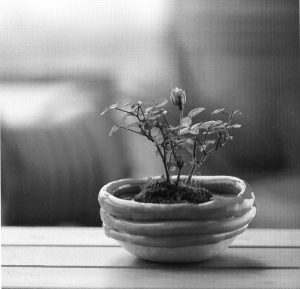 In general, most bonsai are usually highly personalized and there are no strict rules to abide by if you wish to take it up as a mere hobby. Bonsai is typically not an expensive commitment, but it is a commitment that requires a great amount of time, patience, skill and endurance. And even though things do not always go to plan, it’s a hobby that is well worth persevering with – even the greatest Japanese bonsai masters were once humble beginners!
In general, most bonsai are usually highly personalized and there are no strict rules to abide by if you wish to take it up as a mere hobby. Bonsai is typically not an expensive commitment, but it is a commitment that requires a great amount of time, patience, skill and endurance. And even though things do not always go to plan, it’s a hobby that is well worth persevering with – even the greatest Japanese bonsai masters were once humble beginners!
Pop Bonsai
What if traditional bonsai isn’t quite what you are looking for? Perhaps it is just a little too stifling? Fortunately, there is a fresh alternative called “pop bonsai.”
Pop bonsai is a hot, new, freestyle adaptation of the traditional art of growing bonsai created by innovative Japanese bonsai artist Lisa Tajima. While traditional bonsai has many guidelines, pop bonsai throws the rulebook in the rubbish bin and allows practitioners the freedom to grow and display bonsai in wild and wacky ways that fully express their budding imaginations. “Pop bonsai is for people who are living right now,” Tajima said. “The focus is on expressing yourself through bonsai. If you create your own bonsai, it becomes like your pet or a friend. “Tajima’s unique style infuses oodles of her bubbling creativity and allows her to produce bonsai that reflect her style and soul. She designs many of her own pots using quirky, creative and amazingly colorful designs.
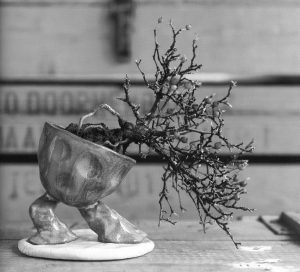
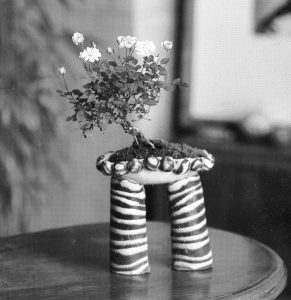
“I wanted to create something new, something I had never seen before,” she said when asked about her motivations behind pop bonsai. She said the method of growing a tree was the same regardless of whether you were practicing traditional or pop bonsai. “What is different is how you play, or arrange the shape of the bonsai,” she said. Her biggest fans are people like her who want to express themselves and are just looking for the material. “Often when people discover pop bonsai, they are inspired and influenced by what they see,” she said. “They see that I have broken the ‘rules’ and now they think they can do it too, which leads the way for them to express their own creativity through bonsai.” The most important challenge is growing bonsai successfully, Tajima said. “Trees are alive and they sometimes become ill, which means we have to be very careful when maintaining them and helping them grow,” she said. “This is the most difficult but most interesting aspect. They are like pets but they never ask for food. When we have very good communication with them, they produce flowers and fruit, which brings the most happiness. “How have people reacted to her breakaway style? “Some people in the traditional bonsai world do not like pop bonsai but others do,” she said. “It is just like music – some people like rock music and others don’t. But I can be good friends with traditional bonsai people if we respect each other and share ideas, although I am not expecting everyone to love me.” More information about pop bonsai and her new book, Pop Bonsai: Fun with Arranging Small Trees and Plants, is available at www.popbonsai.com
REFERENCE
“From bonsai we receive peace of mind, health and a life’s pursuit. We can also learn generosity, patience and even philosophy about life. We can also have the good fortune to make friends of all nationalities and races with whom we share a mutual trust and respect. This is all thanks to bonsai.” – Saburo Kato
First Glimpse
For an absolutely stunning display of beautiful bonsai, visit Takagi Bonsai Museum (1-1 Goban-cho, Chiyoda-ku, Tokyo, Stn: JR Ichigaya Stn, tel: 03-3262-1640, web: www.bonsaimuseum.org) Alternatively, Saitama is home to four fantastic bonsai nurseries, all within easy walking distance of each other: the Seiko-en Nursery (268 Bonsai-cho, Saitama-shi, tel: 048-663-3991); Tojyu-en Nursery (247 Bonsai-cho, tel: 048-663-3899); Omiya Bonsai Village (96 Bonsai-cho, tel: 048-666-2400, web: http://fuyo-en.hoops.ne.jp/); and Mansei-en (285 Bonsai-cho, tel: 048-663-2636). Also, the Oriental Bazaar (5-9-13 Jingumae, Shibuya-ku, Tokyo) in Tokyo’s Harajuku district has a good range of bonsai books in English.
Bonsai websites
National Bonsai Foundation: www.bonsai-nbf.org/links/
North American Bonsai Federation: www.bonsai-wbff.org/nabf/main.htm
Nippon Bonsai Association, Inc. : http://bonsai-kyokai.or.jp (Japanese only)
Dallas Bonsai Garden: www.dallasbonsai.com (a complete line of Japanese bonsai supplies)
BonsaiChat.com: www.bonsaichat.com (gallery, forum, articles and more)
The Bonsai Site at www.bonsaisite.com/index.html (contains a vast array of useful information)
See Bonsai in Japan at www.geocities.com/Tokyo/Palace/7574/japan.html#tokyo for bonsai shops, museums, nurseries, exhibitions and much more.
Bonsai Exhibitions
Sakufu-ten: Held January at the Daimaru Museum, Daimaru Department Store, Tokyo.
Kokufu-ten: Held February at the Tokyo Metropolitan Art Museum, Ueno Park, Tokyo.
Where can you study bonsai in Japan?
The newly opened International Bonsai School run by bonsai master Kunio Kobayashi in the east Tokyo district of Edogawa-ku, Edogawa-ku, Tokyo offers three-, 12- and 24-month courses. Mr Kobayashi is considered to be one of the top bonsai artists in Japan and, by implication, the world. Among many other achievements, he is a four-time winner of the Prime Minister’s Prize at the prestigious Japan Bonsai Exhibition. The same establishment also houses the Shunkaen Museum of Japanese Traditional Art. 10am to 5pm, Tuesday – Sunday. For more information: tel: (03) 3670-8622, Fax (03) 3670-5884.
This article was published with the help of
BonsaiChat.com: www.bonsaichat.com
Dallas Bonsai: www.dallasbonsai.com/
Kodansha International, publisher of Pop Bonsai
Author Lisa Tajima & photographer Hisayoshi Osawa
Bonsai Network Japan: www.j-bonsai.com
Story by Jonathon Walsh
From J SELECT Magazine, September 2004

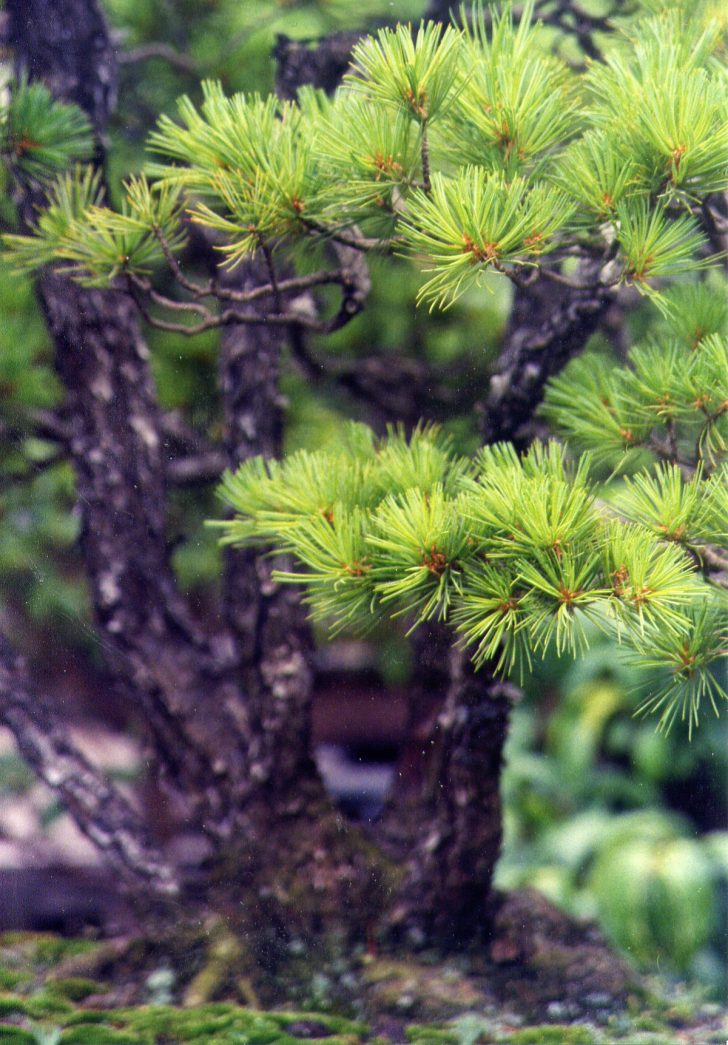

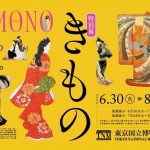
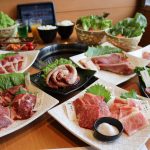

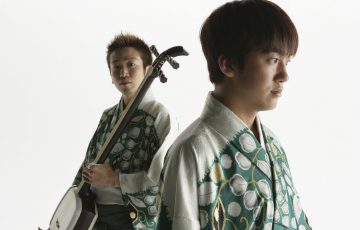

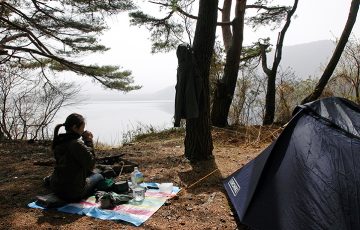

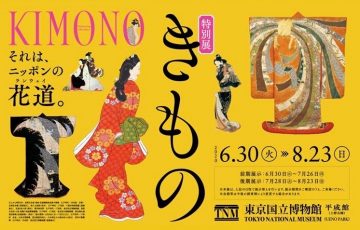
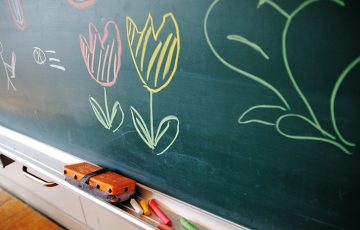



Recent Comments